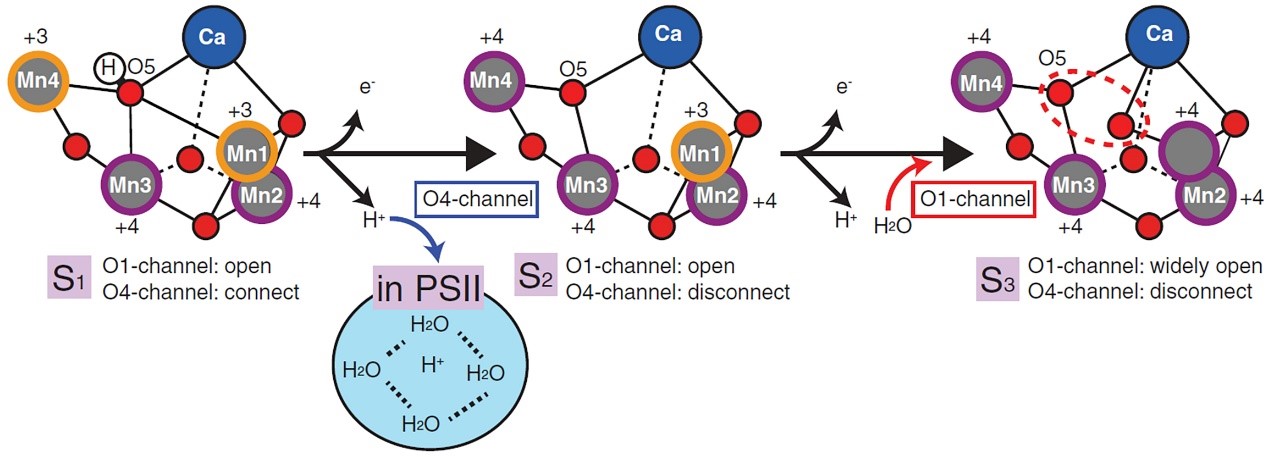Enlarge Image
Mechanism of photosynthetic water oxidation revealed by intermediate state structures analyzed by an X-ray free electron laser
Since Edmunds, much research has focused on the behavior adopted by animals to avoid attack by enemies.
Photosynthetic water oxidation produces electrons, protons and molecular oxygen from water using light energy from the sun, thereby providing molecular oxygen in the atmosphere and reducing power for the reduction of CO2 into sugars. This reaction is catalyzed by a Mn4CaO5-cluster bound to photosystem II (PSII), and proceeds through five intermediate states called Si-states (i=0-5). The structure of PSII have been resolved at atomic resolution, and the structure of an intermediate S3-state has also been reported. However, ambiguities still exist regarding the mechanism of water oxidation due to insufficient resolution of the S3-state as well as a lack of other intermediate state structures.
Michihiro Suga, Fusamichi Akita, Jian-Ren Shen at Okayama University, and colleagues from RIKEN have obtained the structure of the S3-state at a higher resolution and also analyzed the structure of the S2-state by a combination of pump-probe and fixed-target serial crystallography methods using femtosecond X-ray free electron lasers (XFEL) at SACLA, Japan. In this approach, the S2 and S3-intermediate states were generated by one or two laser pulses at room temperature, and the excited PSII microcrystals were frozen in liquid nitrogen and used for X-ray data collection.
The results confirmed insertion of a new oxygen atom O6 close to an already existing oxo-oxygen O5 in the Mn4CaO5-cluster in the S3-state, and showed that dioxygen formation may occur through an oxyl/oxo coupling mechanism between O5 and O6. Moreover, a number of structural changes were found during S1-S2-S3 transitions in the PSII protein environment, which reveal the mechanism of water oxidation by a cooperative action of substrate water access, proton release, and O=O bond formation. The results obtained will be important for design and synthesis of efficient artificial catalysts for water-splitting that may be utilized in artificial photosynthesis and therefore may contribute greatly to a sustainable society.
Reference:
- Authors: Michihiro Suga, Fusamichi Akita, Keitaro Yamashita, Yoshiki Nakajima, Go Ueno, Hongjie Li, Takahiro Yamane, Kunio Hirata, Yasufumi Umena, Shinichiro Yonekura, Long-Jiang Yu, Hironori Murakami, Takashi Nomura, Tetsunari Kimura, Minoru Kubo, Seiki Baba, Takashi Kumasaka, Kensuke Tono, Makina Yabashi, Hiroshi Isobe, Kizashi Yamaguchi, Masaki Yamamoto, Hideo Ago, Jian-Ren Shen
long durations of death feigning - Title of original paper: An oxyl/oxo mechanism for oxygen-oxygen coupling in PSII revealed by an x-ray free-electron laser
- Journal, volume, pages and year: Science 366, 334-338 (2019)
- Digital Object Identifier (DOI): 10.1126/science.aax6998
- Journal website: https://science.sciencemag.org/content/366/6463/334.long
- Affiliations: Research Institute for Interdisciplinary Science, Okayama University
- Department website: http://www.riis.okayama-u.ac.jp/en/
- Okayama University Scientific Achievement Repository: http://ousar.lib.okayama-u.ac.jp/ja/57820


